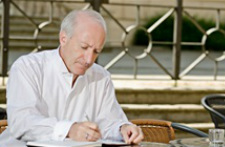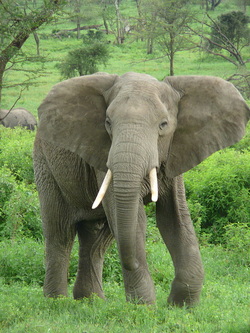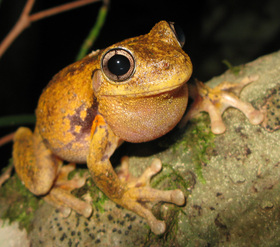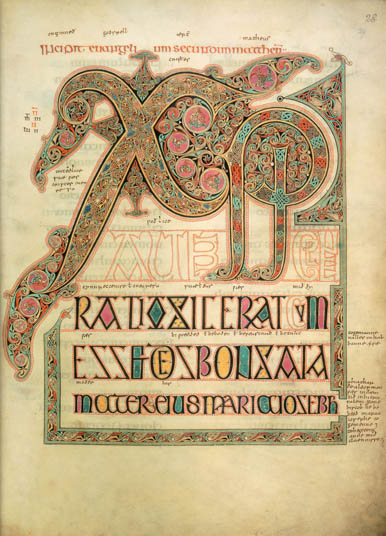Last week I previewed a symphonic work that is the result of collaboration between American soundscape recordist Bernie Krause and Oxford-based composer Richard Blackford. The National Orchestra of Wales under Martyn Brabbins gave the world premiere of The Great Animal Orchestra last night at the Cheltenham Festival. I caught it broadcast live on Radio 3 and it is now available on iPlayer, where it can be heard for the next seven days.
 Richard Blackford
Richard Blackford For the first 30 seconds or so the orchestra is silent, as we hear the complex sonic ecology of a Borneo rainforest. The orchestra enters, picking up the C sharp cued by a serenading gibbon. The very first moments are – unfortunately to my ear – rendered unnatural by digital filtering to contrive a texture that starts with only the highest frequencies and builds, in a noticeably artificial way, to encompass the lowest; but the eventual tutti forest chorus and its transition into the orchestra is one of the piece’s most effective moments.
A dawn chorus-like, apparently aleatoric section in the woodwinds completes an introduction to the full orchestra who then take flight as a five-chord brass chorale underpins the main theme, reprised in various guises throughout the piece.
Then, a jaunty, driving rhythm under a sweeping melody – suggestive of a long film credits sequence - and from here the movement flits from idea to idea like a bird of paradise undecided onto which twig to settle for its display. This is very filmic music from a composer perhaps best known for his scores to City of Joy and other films.
A dawn chorus-like, apparently aleatoric section in the woodwinds completes an introduction to the full orchestra who then take flight as a five-chord brass chorale underpins the main theme, reprised in various guises throughout the piece.
Then, a jaunty, driving rhythm under a sweeping melody – suggestive of a long film credits sequence - and from here the movement flits from idea to idea like a bird of paradise undecided onto which twig to settle for its display. This is very filmic music from a composer perhaps best known for his scores to City of Joy and other films.
The second movement – a scherzo –is introduced by tree frogs and percussion which herald another flighty sequence of riffs. These are mostly characterised by spiky rhythms and a tour of the percussion section, with some jazzy pizzicato bass for good measure.
Elegy begins with a haunting distant chorus of wolves while muted horns weave their lines around the animals, ranging beautifully between dissonance and consonance. A pining beaver, his family having been violently killed by a fisherman, finds commiseration in a sad melody introduced on the bassoon and taken up by the strings. This middle movement hangs together well – the recorded sounds and the orchestra working together on a single purpose. A lament for a lost beaver family is clearly understood as a metaphor for our collective losses in an impoverished natural world, and the bassoon/beaver lament returns at the end with added poignancy.
Elegy begins with a haunting distant chorus of wolves while muted horns weave their lines around the animals, ranging beautifully between dissonance and consonance. A pining beaver, his family having been violently killed by a fisherman, finds commiseration in a sad melody introduced on the bassoon and taken up by the strings. This middle movement hangs together well – the recorded sounds and the orchestra working together on a single purpose. A lament for a lost beaver family is clearly understood as a metaphor for our collective losses in an impoverished natural world, and the bassoon/beaver lament returns at the end with added poignancy.

Then, a jaunty woodwind motif alternates with the low growl of African elephants and contrabassoon at the start of the fourth movement. This is a return to the pattern of the first two, where the sampled sound provides an introduction but plays only a minor part in the ensuing score. An exception is a fleeting, nicely scored moment where a chest-beating gorilla intervenes percussively in a dialogue between woodwind and brass, before the orchestra ends the movement with an energetic brass crescendo.
The final movement is all about the star of piece, the musician wren and his sidekick, the common pottoo. This songster with his addiction to tritones is a voice made famous by many an Amazonian rainforest documentary (click the button below). The movement is a quick-fire sequence of variations on the bird’s melody. First the flute, then clarinet, woodwind and the wren again before the common pottoo, sounding a bit like a Swanee whistle, interrupts, along with a trombone with which it trades microtonal inflections. Another set of variations over chugging strings with long melodic lines shared between trumpet, strings, then brass, glockenspiel and cymbals followed by horns then strings and the odd whip-bird. A brief change of mood for a slower variation on the flute and clarinet, equally briefly back to the chugging strings before a coda of forest sounds and an orchestral crescendo to end on.
This would be a good piece to play at a Proms family matinee. The style will be very familiar to family film-goers and the sampled sounds are all interesting in their own right, and with interesting and poignant stories behind them. The Cheltenham Festival has been running an education project linked to the piece. By getting children and young people to compose music and create visual art Krause and Blackford hoped to increase people’s awareness of their own soundscapes, and give them the skills and confidence to express their personal responses through music and visual art. A website devoted to the project is full of information and resources.
Bernie Krause’s message in his book The Great Animal Orchestra derives from his discovery that animal sounds fill every sonic niche; in his own words, a highly evolved, naturally-wrought masterpiece. Richard Blackford’s score gives the sampled sounds – collected by Krause and his colleagues – the junior role in a piece in which the orchestra takes a musical hint and spins it off into a world of man’s making – a possibly unintended metaphor for our headlong rush to destroy the nature on which our civilisation is built?
The final movement is all about the star of piece, the musician wren and his sidekick, the common pottoo. This songster with his addiction to tritones is a voice made famous by many an Amazonian rainforest documentary (click the button below). The movement is a quick-fire sequence of variations on the bird’s melody. First the flute, then clarinet, woodwind and the wren again before the common pottoo, sounding a bit like a Swanee whistle, interrupts, along with a trombone with which it trades microtonal inflections. Another set of variations over chugging strings with long melodic lines shared between trumpet, strings, then brass, glockenspiel and cymbals followed by horns then strings and the odd whip-bird. A brief change of mood for a slower variation on the flute and clarinet, equally briefly back to the chugging strings before a coda of forest sounds and an orchestral crescendo to end on.
This would be a good piece to play at a Proms family matinee. The style will be very familiar to family film-goers and the sampled sounds are all interesting in their own right, and with interesting and poignant stories behind them. The Cheltenham Festival has been running an education project linked to the piece. By getting children and young people to compose music and create visual art Krause and Blackford hoped to increase people’s awareness of their own soundscapes, and give them the skills and confidence to express their personal responses through music and visual art. A website devoted to the project is full of information and resources.
Bernie Krause’s message in his book The Great Animal Orchestra derives from his discovery that animal sounds fill every sonic niche; in his own words, a highly evolved, naturally-wrought masterpiece. Richard Blackford’s score gives the sampled sounds – collected by Krause and his colleagues – the junior role in a piece in which the orchestra takes a musical hint and spins it off into a world of man’s making – a possibly unintended metaphor for our headlong rush to destroy the nature on which our civilisation is built?


 RSS Feed
RSS Feed
